Tech
5 Tips to Improve the Mobile Messaging Experience for Customers

In today’s digital age, engaging and meaningful mobile messaging through rich communication services has become the preferred mode of communication for millions worldwide. Whether it’s sending a quick text message, sharing photos and videos, or engaging in group chats, mobile messaging has revolutionized the way we connect. However, with the growing popularity of mobile messaging apps, it has become crucial for businesses to prioritize customer satisfaction in this channel.
Customer satisfaction plays a vital role in the future of technology and the success of any business. Satisfied customers are more likely to become loyal brand advocates, refer others to your business, and even make repeat purchases. In the context of mobile messaging, customer satisfaction is equally important. When customers have a positive experience while interacting with your brand through mobile messaging, they are more likely to engage with your business and develop a long-term relationship. On the other hand, a negative experience can lead to frustration, dissatisfaction, and even loss of customers. Therefore, businesses need to understand the mobile messaging landscape and implement strategies to enhance customer satisfaction.
Understanding the Mobile Messaging Landscape
To enhance customer satisfaction in mobile messaging, it is crucial to have a deep understanding of the mobile messaging landscape. Mobile messaging encompasses various platforms, including SMS, mobile messaging apps (such as WhatsApp, Facebook Messenger, and WeChat), and even chatbots. Each platform has its own unique features, capabilities, and user base. By understanding the strengths and limitations of each platform, businesses can tailor their mobile messaging strategies to meet the specific needs and preferences of their target audience.
Expert Tip #1: Personalize Your Mobile Messaging
One of the most effective ways to enhance customer satisfaction in mobile messaging is by personalizing your messages. Personalization goes beyond simply addressing the customer by their name. It involves understanding their preferences, behaviors, and needs, and delivering messages that are relevant and valuable to them. Personalized messages make customers feel valued and understood, increasing their satisfaction with your brand. Personalization can be achieved by leveraging customer data, such as past purchase history, browsing behavior, and demographic information. By analyzing this data, businesses can segment their audience and create tailored messages that resonate with each segment.
Expert Tip #2: Optimize for Different Mobile Devices
Mobile messaging is not limited to a single device or tech platform. Customers use a variety of mobile devices, including smartphones, tablets, and wearable devices. To enhance customer satisfaction, it is crucial to optimize your mobile messaging for different devices. This includes ensuring that your messages are displayed correctly on various screen sizes and resolutions, as well as taking advantage of specific device features, such as push notifications and location services. By optimizing for different devices, businesses can ensure that their messages are accessible and engaging, regardless of the device used by the customer.
Expert Tip #3: Utilize Multimedia in Your Mobile Messages
In today’s visually-driven society, multimedia content has become increasingly important in capturing and retaining customer attention. To enhance customer satisfaction in mobile messaging, it is essential to incorporate multimedia elements, such as images, videos, and audio, into your messages. Multimedia content not only makes your messages more engaging and memorable but also allows you to convey information more effectively. For example, instead of describing a product in text, you can include a high-quality image or a video demonstration. By utilizing multimedia, businesses can create a more immersive and interactive mobile messaging experience for their customers, leading to higher satisfaction.
Expert Tip #4: Provide Quick and Efficient Customer Support
Customer support is a critical aspect of customer satisfaction in mobile messaging. When customers have questions, concerns, or issues, they expect prompt and efficient support from businesses. To enhance customer satisfaction, it is important to provide a seamless customer support experience through mobile messaging. This can be achieved by implementing features like chatbots, automated responses, and real-time chat support. By offering quick and efficient customer support, businesses can address customer queries promptly, resolve issues promptly, and ensure a positive customer experience.
Expert Tip #5: Use Data Analytics to Improve the Mobile Messaging Experience
Data analytics plays a crucial role in enhancing customer satisfaction in mobile messaging. By analyzing customer data, businesses can gain valuable insights into customer preferences, behaviors, and patterns. This data can be used to optimize messaging strategies, personalize communications, and identify areas for improvement. For example, by analyzing customer interactions with mobile messages, businesses can identify the most effective types of content, optimal timing for sending messages, and preferred channels of communication. By leveraging data analytics, businesses can continuously improve the mobile messaging experience and enhance customer satisfaction.
Best Practices for Enhancing Customer Satisfaction in Mobile Messaging
In addition to the expert tips mentioned above, there are several best practices that businesses can follow to enhance customer satisfaction in mobile messaging:
- Respect customer privacy: Ensure that you have the necessary permissions and consent to send messages to customers. Respect their privacy and provide clear opt-out options.
- Maintain consistency: Maintain a consistent tone, style, and branding across all mobile messages to create a cohesive and recognizable brand experience.
- Test and optimize: Regularly test and optimize your mobile messaging strategies to identify what works best for your audience. A/B testing can help you determine the most effective messaging approaches.
- Monitor and respond: Monitor customer feedback and reactions to your mobile messages. Respond promptly to any negative feedback or complaints to address customer concerns.
Case Studies: Examples of Successful Mobile Messaging Strategies
To illustrate the effectiveness of the expert tips and best practices mentioned above, let’s take a look at a few case studies:
- Company X: By personalizing their mobile messages based on customer preferences and purchase history, Company X saw a 20% increase in customer engagement and a 15% increase in repeat purchases.
- Company Y: By optimizing their mobile messages for different devices and screen sizes, Company Y experienced a 30% increase in click-through rates and a 25% decrease in bounce rates.
- Company Z: By incorporating multimedia elements, such as product images and videos, into their mobile messages, Company Z achieved a 40% increase in message open rates and a 35% increase in conversion rates.
Conclusion: Elevating the Mobile Messaging Experience for Customer Satisfaction
In conclusion, enhancing customer satisfaction in mobile messaging is crucial for businesses to thrive in today’s digital landscape. By personalizing messages, optimizing for different devices, utilizing multimedia, providing efficient customer support, and leveraging data analytics, businesses can create a seamless and engaging mobile messaging experience for their customers. By following the expert tips and best practices outlined in this article, businesses can elevate the mobile messaging experience, drive customer satisfaction, and ultimately build long-term customer relationships.
-
Blog1 year ago
MyCSULB: Login to CSULB Student and Employee Portal – MyCSULB 2023
-
Android App3 years ago
Cqatest App What is It
-
Android1 year ago
What Is content://com.android.browser.home/ All About in 2023? Set Up content com android browser home
-
Software2 years ago
A Guide For Better Cybersecurity & Data Protection For Your Devices
-
Latest News2 years ago
Soap2day Similar Sites And Alternatives To Watch Free Movies
-
Android2 years ago
What is OMACP And How To Remove It? Easy Guide OMACP 2022
-
Android3 years ago
What is org.codeaurora.snapcam?
-
Business2 years ago
Know Your Business (KYB) Process – Critical Component For Partnerships

























